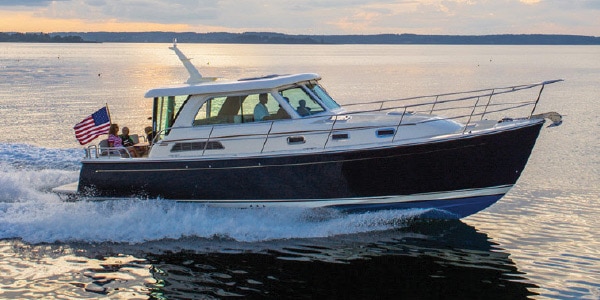

Examining Back Cove’s Single Engine Success
Keeping it Simple
Several propulsion options were considered when the engineers and design team at Sabre Yachts first set out to create the Back Cove models. Kevin Burns, Vice President of Design & Product Development provided us with a break-down of that initial research and development phase. “Fundamentally, looking at all the driveline options available at that time, the simplest and most reliable is an inboard straight shaft single diesel engine with a rudder.” Burns continues, “even large shipping vessels and commercial fishing boats use this configuration due to ease-of-maintenance and reliability.”
Not only is a single engine configuration a tried-and-true approach throughout multiple marine segments, it also provides many other advantages over twin engines of equivalent horsepower output. “In terms of cost, there is a huge advantage for the single engine setup,” explains Bluewater’s Mark Connors. “From initial purchase price to cost of maintenance, a single engine keeps the financial burden much lower than a boat with twin engines.”
A second inboard does more than just double the cost of the engines, spare parts and upkeep—it also increases the required cooling, number of thru hulls, and fuel capacity. Twin engines need twice the amount of exhaust plumbing, which can add complexity to the build and greatly reduce the amount of available space below-decks. “A single engine takes up much less space, giving the owner additional storage to work with. Maintenance becomes easier as both sides of the engine are more readily accessible,” Connors explains.





Beam
Draft
Displ.
Fuel
Water
Holding
Power
13’ 4”
3’ 4”
21,500 lbs.
300 gal.
100 gal.
40 gal.
Twin Volvo
D4 IPS @ 300 hp ea.
Beam: 13’ 4”
Draft: 3’ 4”
Displ.: 21,500 lbs.
Fuel: 300 gal.
Water: 100 gal.
Holding: 40 gal.
Power: Twin Volvo
D4 IPS @ 300 hp ea.


Beam
Draft
Displ.
Fuel
Water
Holding
Power
13’ 3”
3’ 7’’
22,100 lbs.
300 gal.
120 gal.
50 gal.
Single Cummins
QSC 8.3 @ 600 hp
Beam: 13’ 3”
Draft: 3’ 7”
Displ.: 22,100 lbs.
Fuel: 300 gal.
Water: 120 gal.
Holding: 50 gal.
Power: Single Cummins
QSC 8.3 @ 600 hp

A Winning Formula
“A great deal of thought and concern has gone into choosing the driveline and it absolutely makes the most sense from every angle… quality, cost savings, ease of maintenance, service life, and robust materials & equipment,” Burns concludes. With a 240,000 square foot facility in Rockland, Maine and 200 remarkably talented team members, most Back Cove models can go from hull lay-up to final delivery prep in roughly 90 days, which helps keep up with the impressive demand these boats have developed.
“…a single engine keeps the financial burden much lower than a boat with twin engines.”
“After running a Back Cove 37 Downeast, you’ll be impressed with the ride and efficiency, plus the noise levels at the helm are very low. Back Cove Yachts are fantastic for a couple who like to entertain as well as spend a few nights aboard cruising,” advised Connors. Bottom line, boat shopping should always be accompanied by a little homework and the expertise of a well-versed sales professional who can help guide you towards the best boat for your lifestyle. Efficiency and ease-of-operation are just some of the highlights of a single screw cruising champion that shouldn’t be ignored. If you’re a fan of Downeast style cruisers, take a good look at Back Cove and sea trial one—we think you’ll be awed by its mix of performance, refinement and value.